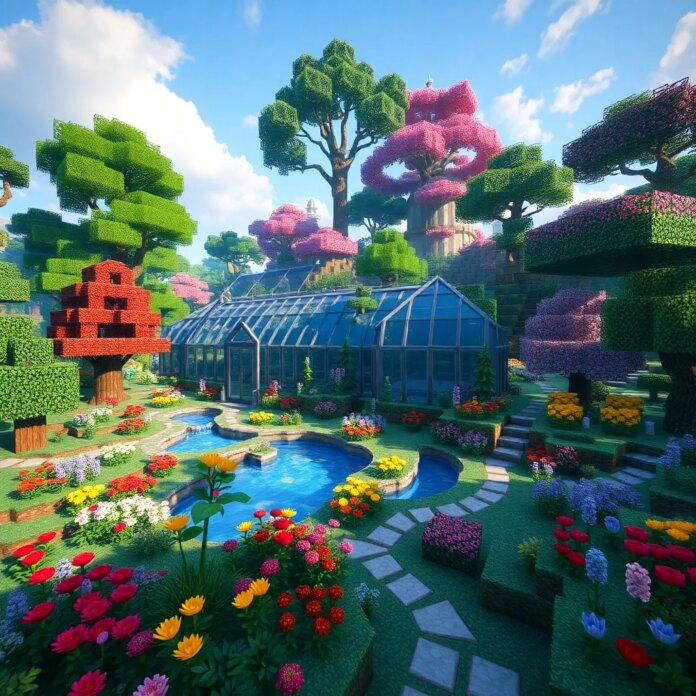Minecraft gardens: creative oases in the virtual world
Minecraft offers players an endless canvas for creative building projects, and gardens and botanical gardens are among the most popular projects in the community. These green oases give every Minecraft world a special atmosphere and invite you to linger. From small, cozy backyard gardens to sprawling botanical gardens - the possibilities are as diverse as the flowers and plants the game has to offer.
Planning and designing the floor plan
A well-designed Minecraft garden often starts with planning the layout. Many players opt for a mixture of structured areas and natural-looking landscapes. Paved paths made of different types of stone such as quarry stone or brick lead through flowering beds and past rippling water features. Small bridges over artificial streams or ponds add an extra dimension to the garden and create attractive eye-catchers.
The planning covers several aspects:
- Functionality: Areas for relaxing, planting and decorating should be clearly defined.
- Aesthetics: A harmonious choice of colors and materials ensures an appealing overall look.
- Integration: The garden should fit seamlessly into the existing Minecraft world.
Choosing the right plants and materials
Choosing the right plants plays a crucial role in creating an attractive garden. Minecraft offers a variety of flowers, including roses, daisies, sunflowers and orchids, which can be placed in artfully arranged beds. Trees such as oaks, birches or the exotic acacias provide height and shade. For a tropical touch, bamboo plants or colorful coral blocks can be placed under water.
In addition to plants, various materials can be used to embellish the garden:
- Blocks: Different types of stone, wood and glass blocks offer numerous design options.
- Decorations: Flower pots, lanterns and torches add decorative elements.
- Figures: Partitions with custom heads such as garden gnomes or exotic animals can make the garden look more lively.
Height levels and depth structure
Advanced gardeners in Minecraft often experiment with different height levels to give their gardens more depth. Terraced gardens that climb up hills or hanging gardens inspired by the Hanging Gardens of Babylon are impressive projects that enrich any Minecraft world. Stairs, steps and half-blocks can be used to create smooth transitions between the different levels.
Additional ideas for height levels:
- Terraces with different plant species on each level.
- Hanging planters under bridges or terraces.
- Roof gardens on tall buildings for additional green spaces.
Greenhouses and functional structures
Greenhouses or glasshouses are a popular element in Minecraft gardens. These can be constructed from glass blocks and iron bars and provide space for exotic plants or crops such as wheat, carrots and potatoes. Such structures not only add visual variety to the garden, but also serve as functional spaces for food production in survival mode.
Tips for building a greenhouse:
- Use different types of glass for more variety.
- Integrate ventilation systems made of iron grids or planters.
- Illuminate the greenhouse with glowstone or soul lanterns for an atmospheric ambience.
Water elements for a refreshing ambience
Water is another important design element in Minecraft gardens. Fountains, ponds and waterfalls bring movement and a refreshing ambience to the garden. With a little skill, you can even create complex water features with the help of redstone mechanisms that give the garden an interactive component.
Possible water elements:
- Create ponds in different sizes and shapes.
- Create waterfalls with multiple layers for a dynamic appearance.
- Integrate underground rivers or streams for hidden surprises.
Integration of animal life for more liveliness
For a particularly natural atmosphere, many players also integrate animal life into their gardens. Beehives surrounded by blooming flowers are not only decorative, but also useful for honey production. Small ponds can be stocked with tropical fish, while aviaries for parrots provide a colorful accent.
Further ideas for integrating animal life:
- Chicken coops along the garden paths for added charm.
- Paddocks for horses or donkeys next to the seating areas.
- Fixed feeding stations for birds and butterflies.
Lighting for an atmospheric ambience
Lighting plays an important role in making the garden attractive at night too. Lanterns, torches or the atmospheric soul lanterns can be placed along the paths. Glowstone blocks, which can be incorporated into flowerbeds or water features, are also suitable for creating a magical ambience.
Lighting tips:
- Use natural light sources such as lanterns in trees.
- Use different types of lighting for different areas.
- Use vertical lighting on high structures such as trees or fences.
Education and information in botanical gardens
Botanical gardens in Minecraft often go beyond the boundaries of an ordinary garden. They can be designed as educational facilities where different biomes and plant species from the game are represented. Information boards, created with signs, can provide visitors with knowledge about the different plants and their characteristics.
Further educational ideas:
- Create thematic paths for different plant categories.
- Integrate interactive elements such as quiz stations or plant puzzles.
- Organize virtual tours or workshops within the garden.
Thematic gardens for special accents
A particular attraction lies in the design of themed gardens. A Japanese zen garden with carefully arranged gravel, stone lanterns and a small pond with koi carp is just as possible as a wild jungle garden with lush vegetation and hidden ruins. Medieval herb gardens, futuristic hydroponic plants or even extraterrestrial gardens with strange, self-designed plants made of colored blocks and particles are left to the imagination of the players.
Popular topics:
- Zen gardens: Minimalist designs with clean lines and selected plants.
- Tropical gardens: Lush vegetation, colorful flowers and exotic animals.
- Medieval gardens: Herb beds, old stone walls and decorative fountains.
- Futuristic gardens: Modern structures, bright elements and innovative plant arrangements.
- Alien gardens: Imaginative plants and colorful blocks for an extraterrestrial flair.
Seating and relaxation areas
The integration of seating and relaxation areas completes every Minecraft garden. Benches made from steps and signs, cozy gazebos or hidden arbors invite you to linger. Swings built with chains and wooden planks add a playful touch.
Ideas for relaxation areas:
- Build a pavilion with a canopy for shade and shelter.
- Place garden stools or cozy seating groups under bushes and trees.
- Integrate watercourses or small waterfalls into the relaxation zones.
Personalization with custom heads and decorations
For those who want to bring their gardens to life, there are custom heads - special blocks that look like small statues or decorations. They can be used to create garden gnomes, exotic birds or even small pieces of garden furniture to give the garden a personal touch.
Further decoration ideas:
- Use banners and carpets for colorful accents.
- Use planters and flower boxes as decorative elements.
- Incorporate seasonal decorations to keep the garden interesting all year round.
Plant care in survival mode
Maintaining a Minecraft garden can be a satisfying task even in survival mode. Regularly harvesting and replanting crops, pruning trees with shears and fertilizing the soil with bone meal are activities that keep the garden alive and ever-changing.
Tips for plant care:
- Create automated farms with Redstone for efficient harvesting.
- Use composters and bonemeal to accelerate plant growth.
- Protect your garden from monsters and animals that could destroy the plants.
Major projects: Parks and botanical wonders
For particularly ambitious gardeners, Minecraft offers the opportunity to create entire parks or botanical gardens. These can cover several hectares and include various themed areas, nature trails and even small zoos or aquariums. Such large-scale projects often require the cooperation of several players and can become impressive sights on multiplayer servers.
Elements of major projects:
- Various themed gardens within a large complex.
- Strolling paths with covered walkways and information stations.
- Integration of water landscapes such as lakes and rivers for natural design.
- Small attractions such as labyrinths, sculpture parks or play areas.
Promoting creativity and closeness to nature
The beauty of Minecraft gardens lies not only in their aesthetic value, but also in their ability to foster creativity and a connection to nature. They provide a platform for players to expand their knowledge of plants and landscaping while creating relaxing, virtual spaces.
Advantages of Minecraft gardens:
- Creativity: Players can realize their ideas and designs in the virtual world.
- Relaxation: Gardens provide a quiet environment within the game to relax.
- Learning: Players learn about plant species, garden care and landscape design.
- Community: Joint gardening projects promote cooperation and the exchange of ideas.
Final thoughts: The future of Minecraft gardens
Whether as part of a larger base, a standalone project or a collaborative endeavor, Minecraft gardens and botanical gardens remain a fascinating aspect of the game. They reflect players' love of nature and show how even in a world of blocks, the beauty and diversity of plant life can be celebrated. With every new Minecraft version and every creative idea from the community, the possibilities grow to create ever more impressive green paradises that are both pleasing to the eye and soothing to the soul.
Future developments could be:
- New plant species and blocks for even more realistic gardens.
- Extended Redstone options for more complex water features and automated systems.
- Integration of mods and plugins that offer additional garden elements and functions.
- More interactive elements such as weather and daily cycle-dependent plant growth.
Discover the unlimited possibilities and let your creativity run wild to create your own unique Minecraft garden!





